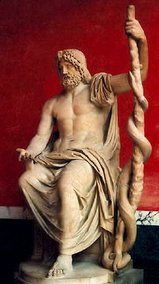Have you noticed the symbols used in relation to medicine?

Which of these is it?
< >
Actually the medical professionals also have been confused in the use of these two symbols.The staff entwining a single serpent –believed to be a rat snake species- is known as Rod of Asclepius.
 Asclepius was the god of medicine & healing in the Greek mythology. He was the son of Coronis -a mortal- & Apollo -a Greek god-, brought up by Chiron -a centaur-, who thought him all his skills in Medicine. Zeus killed him with a thunder bolt. Many reasons are speculated for this killing, one reason being acceptance of money in return for resurrection. These have to be discussed separately.
Asclepius was the god of medicine & healing in the Greek mythology. He was the son of Coronis -a mortal- & Apollo -a Greek god-, brought up by Chiron -a centaur-, who thought him all his skills in Medicine. Zeus killed him with a thunder bolt. Many reasons are speculated for this killing, one reason being acceptance of money in return for resurrection. These have to be discussed separately.
Then realizing his importance Zeus made him immortal & placed in the sky as the Ophiuchus among the stars.
 The other one is Caduceus of Hermes or Kerykeion of Mercury. It depicts a staff with wings with two snakes wrapped around it. Hermes is the Greek god of boundaries, of travelers, shepherds and cowherds, of orators, literature and poets, of athletics, of weights and measures and invention, of commerce in general, of the cunning of thieves, and the messenger from the gods to humans. Mercury is the Latin god of trade, profit and commerce.
The other one is Caduceus of Hermes or Kerykeion of Mercury. It depicts a staff with wings with two snakes wrapped around it. Hermes is the Greek god of boundaries, of travelers, shepherds and cowherds, of orators, literature and poets, of athletics, of weights and measures and invention, of commerce in general, of the cunning of thieves, and the messenger from the gods to humans. Mercury is the Latin god of trade, profit and commerce.
Thus Rod of Asclepius is more relevant to be used as a symbol of Medicine rather the Caduceus or Kerykeion which is more connected with commerce. But Hermes also is connected with alchemy in the form of hermetic spells, which is a precursor of medicine


< Logo of British medical association
Logo of World Health Organisation >









